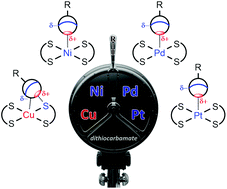Electron belt-to-σ-hole switch of noncovalently bound iodine(i) atoms in dithiocarbamate metal complexes†
Abstract
Co-crystallization of dithiocarbamate complexes [MII(S2CNEt2)2] (M = Cu 1, Ni 2, Pd 3, Pt 4) and 1,3,5-triiodotrifluorobenzene (FIB) gives an isomorphic series of (1–4)·2FIB co-crystals exhibiting quadruple Cu/Ni/Pd/Pt isostructural exchange. In the structures of (1–4)·2FIB, the halogen-bonded C–I⋯M (Ni, Pd, Pt) and semicoordination M⋯I–C (Cu) metal-involving contacts were identified by X-ray diffractometry and their nature was verified theoretically. The directionality of the Iσ-hole⋯d2zMII and MII⋯Ielectron belt interactions depends on the identity of a metal center: on going from a rather electrophilic CuII to substantially more nucleophilic NiII, PdII, and PtII centers, we observed the electron belt-to-σ-hole switch of a noncovalently bound iodine(I) of FIB and, correspondingly, its shift from semicoordination to halogen bonding. The negative values of the electrostatic potentials (given in parentheses) were estimated for all metal centers and they decrease in the order CuII (−8.8) > NiII (−24.5) > PdII (−28.6) > PtII (−33.3 kcal mol−1). Despite the negative potentials at all MIIs, the semicoordinative contact Cu⋯I was established by the recognition of the LP(I) → LP*(Cu) charge transfer using natural bond orbital (NBO) analysis and the comparison of electron density (ED) and electrostatic potential (ESP) minima positions along the I⋯Cu bond paths. In the case of the rather nucleophilic (although positively charged) PdII and PtII centers, the contacts C–I⋯d2z[Pd] and C–I⋯d2z[Pt] can be attributed to the unconventional metal-involving halogen bonding; these contacts are among the strongest (4.30 and 5.42 kcal mol−1, correspondingly) between any metal center and iodine(I)-based σ-hole donors.

- This article is part of the themed collection: FOCUS: Macrocyclic and supramolecular chemistry


 Please wait while we load your content...
Please wait while we load your content...